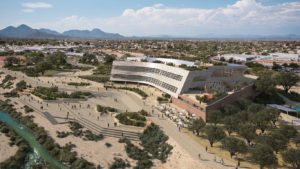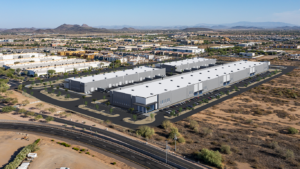Arizona’s tribal casinos brought in close to $25 billion from 2004-2017, according to annual tribal contribution reports by the Arizona Department of Gaming. In total, there are currently 16 Tribes operating 24 casinos throughout the state.
There’s no doubt these casinos are bringing in big bucks, but Arizona casinos are also attracting big commercial investment and development interest to the tribal communities and surrounding areas.
New casinos projects like the $400 million Desert Diamond West Valley Casino that broke ground in December have people interested in what additional development opportunities might arise and how it will further define the surrounding area.
The project will bring five restaurants and 75,000 square feet of slot machines, blackjack, poker and bingo to Northern Avenue and the Loop 101, replacing the temporary, slot machine-only gaming facility that was built in 2015 in the same area.
Construction of the new casino is expected to take 24 months, but the Tohono O’odham Gaming Enterprise is already planning to add a hotel, spa and other resort amenities during future phases. At full buildout, the Desert Diamond West Valley Casino is projected to be over one-million square feet, and employ 3,000 workers.
Meanwhile, existing casinos undergo renovations to stay competitive just as a density movement draws more development and investor interest to tribal communities and nearby casinos.
From desert to casino
When Ak-Chin Indian Community Chair Robert Miguel was growing up, the area where Harrah’s Ak-Chin Casino would be built was desert, mesquite trees and rocks. Community members came to the area to enjoy the nature, he remembers.
Over the years, that area has gone from raw desert to hospitality haven. The Harrah’s Ak-Chin Casino would be built in 1994, continuously growing over the decades.
Next door to the casino, the 165,000-square-foot UltraStar Multi-tainment Center was built, adding a movie theater, bowling alley, laser-tag, arcade and event center, which kept folks in the region for their entertainment needs, instead of driving to Casa Grande or Metro Phoenix.

More recent construction includes a multi-million-dollar expansion of Harrah’s Ak-Chin Casino that will add ballroom space, more restaurants and 200 guestrooms while updating the facilities with a more modern ascetic. A sky bridge connecting the casino with the UltraStar Multi-tainment Center is also in the works.
The casino isn’t getting all of the excitement though, as it helps boost awareness of this growing community.
“The enhancement and expansion of the casino and entertainment centers really bolstered the interest of companies and enterprise that may want to relocate out here,” Miguel says.
Lately, both the Ak-Chin Community and City of Maricopa have been fielding many inquiries about future development potential in the area, he explains.
Miguel has spoken with three separate manufacturing companies and hotel developers since interest in the community has grown, saying the community gets requests from companies looking to relocate a couple of times per month.

Other investor interest has been spurred by the community’s purchase of the Phoenix Regional Airport, which was renamed to the Ak-Chin Regional Airport, and upgraded.
The more the community progresses, the more interest it will be able to create, Miguel says.
Talking Stick’s success sets standard
Since Talking Stick Resort and Casino was built, the area known as the Talking Stick Entertainment District has grown a great deal within the Salt River Pima-Maricopa Indian Community (SRPMIC).
When the resort was completed in 2010, the economy was still in the midst of its slump and there wasn’t much development happening in the area, says Martin Harvier, vice president of the SRPMIC.
Not long after Talking Stick Resort was completed, the community had the opportunity to develop Salt River Fields, which was the first spring training facility to be built on Native American land.
Between the completion of those two projects and now, the SRPMIC has become home to many other developments.
Part of the area’s success has to do with its prime location near Scottsdale and the Loop 101, Harvier says, but a lot of what the SRPMIC has been able to accomplish was through the community’s opportunity to game with its casinos.
“With Talking Stick Resort being the first to be there, and then the ball field, everything else took off from there,” he says. “It’s really surprising to see the developments happening.”

OdySea in the Desert, the newest entertainment hub, built on 35-acres of SRPMIC land in 2016 by McCarthy Building Companies, now includes approximately 20 restaurants and other interactive experiences like an ice bar called Polar Play, the OdySea Mirror Maze, the Aqua Massage & Oxygen Bar and the Carousel Arcade.
The community has seen success outside of hospitality projects as well, attracting mega office, retail and mixed-use projects.
Developed by The Alter Group, the $400 million Riverwalk at Talking Stick, is one of the country’s largest developments on Native American land, which will yield an estimated 1.5-million square feet of corporate office and retail space and create up to 15,00 jobs at full buildout.
There’s also the Pima Center, a 209-acre, mixed-use business park developed by Main Spring Capital Group along the northwest corner of the SRPMIC. Meanwhile, the SRPMIC has developed the Scottsdale Autoshow at Salt River and the Pavilions at Talking Stick.
Greg Mayer, senior director at Cushman & Wakefield specializing in office space, says, if the SRPMIC was marked as its own submarket, it would be one of the most competitive markets in the Metro Phoenix area.
One of the biggest, and perhaps most impactful developments has been the 271,000-square-foot regional headquarters that the McKesson Corporation occupies on SRPMIC land.
McKesson is a Fortune 500 healthcare and technology company that will bring 2,200 jobs to the area over the next few years, which is a huge regional win for the community in drawing the attention of other office users.
“We have about 600,000 [square] feet of active prospects looking to be within a two-mile radius of that McKesson building,” Mayer says. “There’s demand that exceeds supply currently.”
However, there’s hundreds of developable acres for offices available at development parks like Riverwalk at Talking Stick, Calendar Stick Business Park, Pima Center and the Chaparral Business Center within the SRPMIC.
The community has provided modern infrastructure, telecommunications systems, plenty of entertainment and dining options while capitalizing on its close proximity to Scottsdale and ease of access to the rest of the Valley.
All of this have been helping drive development in the area.
“Tribal communities are beneficial, not only to our Tribes, but I really believe we’re a player and benefit to the areas that are surrounding us as far as the economy goes,” Harvier says.
The economic impact
For Arizona’s tribal communities, casinos have played a wide range of roles. While bringing in jobs, tourists and money for the communities, they’ve also helped boost the recognition of each casino’s respective community.
The Ak-Chin Community has seen considerable growth since the development of Harrah’s Ak-Chin Casino, and there is only more opportunity on the horizon as the surrounding communities continue to grow.
Miguel says the Ak-Chin Community is looking to develop the surrounding farm fields near the casino into added features and amenities that will help accommodate the area’s growth.
The Ak-Chin Community is a hidden gem, he says, and businesses looking to grow and relocate in the area may find that both Maricopa and the Ak-Chin Community are ideal places to start a business and raise a family.

Michael Gonzalez, project director for McCarthy Building Companies, a general contracting company that has done work on many local projects on Native American lands, says, the goals of the Tribe and its council when developing are typically focused on driving the economy.
McCarthy Building Companies has done work on OdySea in the Desert and is currently working on the expansion of the Pascua Yaqui Tribe’s expansion of Casino Del Sol in Tucson, which will add 150 rooms, more convention space and 90 RV sites once completed.
This project intends to support the Tribe’s economic development goals by allowing the Pascua Yaqui Tribe to provide new options to community members and the surrounding community and businesses, says Kurt Nyberg, the McCarthy Building Companies project director for the Casino Del Sol expansion.
“Casino Del Sol has been successful in attracting guests, businesses and golfers over the years. Since they have a good understanding of what the needs and desires of their community and consumer, enhancing their project in these ways will undoubtedly have a positive impact,” Nyberg says.
Looking ahead, keep an eye out for more commercial investment and development prospects on tribal lands as other businesses and investors also try to cash in on emerging opportunities near casinos.




